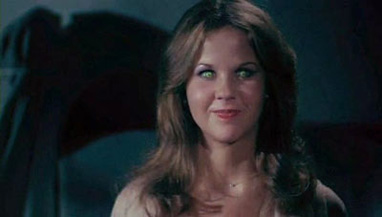Chapter Two
Exorcist II: The Heretic
By Brett Ballard-Beach
September 1, 2011
Boorman’s 118 minute cut was roundly jeered at Exorcist II’s premiere and he set about tweaking it, resulting in a version with a running time of 110 minutes that is the one that wound up going out to theaters. The former version is the one released on DVD and that I viewed; the latter is harder to come by, although between the alternate opening available as an extra on the DVD, a YouTube video of the abbreviated climax of the VHS version and a German website that painstakingly compares differences between those two cuts and a third even shorter version, replete with hundreds of screen shots and some iffy English translations, I feel somewhat enlightened and even more confident that the many flaws (and a few virtues) of Boorman and Goodhart’s vision are consistent no matter the running time.
To start with, consider that the title that appears onscreen (and as far back as the early trailers) is “John Boorman’s film of Exorcist II: The Heretic”, not one of the more common and expected possessives “a film by John Boorman” or “a John Boorman film.” It’s...unusual in its wording and suggests a disconnect between the screenplay and what plays on the screen. Boorman and his frequent collaborator Rospo Allenberg apparently made numerous revisions to the script (although neither was able to claim a credit) and the finished product is markedly different from early drafts. As a side note, one of my many Google searches directed me to a website offering up a 1976 copy of the script, draft dated right before filming commenced, for only $245.
The Heretic is founded upon an interesting premise - an investigation into the events surrounding the exorcism in the first film by a peer of Father Merrin’s, at the request of the Catholic Church, to determine if Merrin’s views on the existence of the Devil and the sway of evil stepped out of line with Church dogma towards the end of his life and if he subsequently needs to be whitewashed out of the record, in a manner of speaking. Father Lamont is chosen for this task and his inquiry necessarily brings him into the orbit of Regan, and from there, into a confrontation with the demon from the first film, as well as the reasons why Regan was specifically chosen by the demon.
I find it compelling that when Blatty chose to write his own book sequel to The Exorcist (Legion in 1983) and later adapted and directed it for a different studio as The Exorcist III in 1990, he focused almost exclusively on the characters that hadn’t been included in The Heretic and crafted a metaphysical detective story that quite neatly complements the religious and faith-based inquiry Lamont conducts in The Heretic. And both of those represent the two most obvious paths of a continuing narrative to emerge from the finale of The Exorcist (whether Blatty intended for there to be such an obvious window for sequels I don’t know, but it exists there as blatantly as the concluding scene of John Carpenter’s Halloween or any slasher film from the 1980s).
In telling its tale, The Heretic suffers from ironic fits of pacing: in rushing to throw a whole host of ideas and back story into the plot in the first half, the story drags unmercifully under a weight of a lot of information that only becomes understandable in hindsight. The second half is payoff for all the setup but even as it builds towards a bravura “love it or hate it climax”, it feels rushed, and ends rather abruptly (even more so in the 110 minute edit). But the two biggest anchors to the film ever taking off are poor performances and the film’s inability to convey in visual and rhetorical terms its key plot linchpin (psychic phenomena), without evoking utter incredulity from the audience.
Continued:
1
2
3
4
5
|
|
|
|




